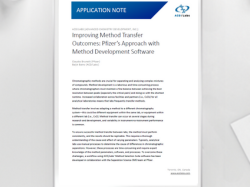Balancing the efficacy and safety of preservatives in multidose products
Posted: 2 November 2017 | Dave Elder | No comments yet
The EMA recently introduced labelling requirements for some common excipients based on an in-depth assessment of their safety profiles, particularly in the paediatric population.1 This article considers their use in multidose products…


The excipients covered include: aspartame, benzalkonium chloride, benzoic acid, benzyl alcohol, boric acid, cyclodextrins, ethanol, fragrance allergens, fructose and sorbitol, phosphates, propylene glycol (and esters), sodium, sodium lauryl sulfate and wheat starch (including gluten). Those preservatives covered under labelling requirements include benzalkonium chloride, benzoic acid, benzyl alcohol, boric acid and ethanol. Antimicrobial preservatives are: “Normally added to prevent microbial proliferation arising under in-use conditions. The properties are due to certain chemical groups which are usually harmful to living cells and might, therefore, be associated with certain risks when used in man.”2 The key principle is that: “Inclusion of antimicrobial preservatives in a finished product needs special justification. The use of these substances should be avoided in general, especially when considering the suitability of related formulations to the paediatric population”.3
As such, the EMA has long articulated the view that preservative-free formulations (particularly for ophthalmic preparations) should be considered whenever possible for use in the paediatric population and particularly in neonates.3 However, despite the widespread availability of single-use ophthalmic presentations, eg, blow-fill-seal(BFS) units, there are some significant issues. The cost of these BFS presentations is five to 10 times higher than multi-use presentations. BFS aren’t always easy to dose either from a patient or from a carer perspective, due to the plastic container’s lack of suppleness.4 The serrated edges of the opened BFS container can irritate the patient’s eye, particularly in the elderly where hand-eye coordination is poor.5 The drop size, and hence dose, can be variable and dependent on the size of the aperture created during opening.6 As such, a general recommendation not to use preservatives in eye preparations, based on a review of the available safety data is not supportable.7
For oral products, Kozarwicz3 voiced a commonly held view that: “Instead of developing multidose liquid formulations requiring preservation alternatives such as solid dosage forms (granulates, granules in sachets, bulk granules in bottles with measuring devices, individual ‘dry’ doses that can be converted to liquid prior to use) should be investigated.” This assumes that, as granule products are intermediates of the adult medicinal product, eg, tablets or capsules, they can be seamlessly adopted as paediatric products. However, the intermediate granule is often not fit for purpose and needs to be fully optimised.
A major challenge is palatability, which often necessitates coating or complexation approaches to provide a barrier preventing the drug granules from dissolving in the buccal cavity and masking the poor taste of the drug.8 However, from an efficacy perspective the patient must then swallow the entire dose, ie, all the granules. And because these granule-based products are often difficult to fully suspend prior to dosing compared to a bespoke suspension, sub-optimal doses may arise. Secondly, the flow properties of these granule-based products are often sub-optimal for commercial filling operations into sachets.9 In addition, patient adherence/compliance is often linked to the ease of use of such products.10 Thus a patient or carer that needs to reconstitute a product three times a day for seven days, ie, 21 unit operations, is less likely to be compliant than one who merely needs to dispense a dose of the bespoke suspension product to the patient.
It is often simplistically assumed that: “It is nearly always technically possible to re-think the product development to remove them (preservatives) or minimise their use.”3 Unfortunately, this isn’t the case and significant effort is required to develop safe, multi-use products suitable for use in special populations.
BIOGRAPHY
Dave Elder has nearly 40 years of service within the pharmaceutical industry at Sterling, Syntext and GlaxoSmithKline. He is now an independent GMC consultant. Dr Elder is a visiting professor at King’s College, London, and is a member of the British Pharmacopoeia. He is a member of the Joint Pharmaceutical Analysis Group (JPAG), and a member of the Analytical Division Council of the Royal Society of Chemistry.
REFERENCES
- Excipients labelling. EMA. 2017. www.ema.europa.eu/ema/index.jsp?curl=pages/regulation/general/general_content_001683.jsp&mid=WC0b01ac05808c01f6. Accessed on 22 September 2017.
- Guidelines on excipients in the dossier for marketing authorisation of a medicinal product. EMA. 2006. EMEA/CHMP/QWP/396951/2006.
- Kozarewicz P. 2010. Preservatives: Are they safe? 31 May 2010. www.ema.europa.eu/docs/en_GB/document_library/Presentation/2010/09/WC500096784.pdf. Accessed on 25 September 2017.
- Furrer P, Mayer JM, Gurny R. Ocular tolerance of preservatives and alternatives. Eur J Pharm Biopharm. 2002;53:263-280.
- Loeffler M, Hornblass A. Hazards of unit dose artificial tear preparations. Arch Ophthalmol. 1990;108:639-640.
- Van Santvliet L, Sam T, Ludwig A. Packaging of ophthalmic solutions – influence on stability, sterility, eye drop instillation and patient compliance. Eur J Pharm Biopharm. 1996;42:375-384.
- EMEA public statement on antimicrobial preservatives in ophthalmic preparations for human use. EMA. 2009. EMEA/622721/2009.
- Douroumis D. Practical approaches of taste masking technologies in oral solid forms. Expert Opin Drug Deliv. 2007;4(4):417-26.
- Freeman T, Brockbank K, Sabathier J. 2017. Characterising powder flow properties – the need for a multivariate approach. EPJ Web of Conferences. 2017;140:03008 (2017) DOI: 10.1051/epjconf/201714003008, Powders & Grains, 1-4. www.epj-conferences.org/articles/epjconf/pdf/2017/09/epjconf161901.pdf. Accessed on 25 September 2017.
- Adherence to long-term therapies: Evidence for action. WHO. 2003. http://apps.who.int/medicinedocs/pdf/s4883e/s4883e.pdf. Accessed on 25 September 2017.









